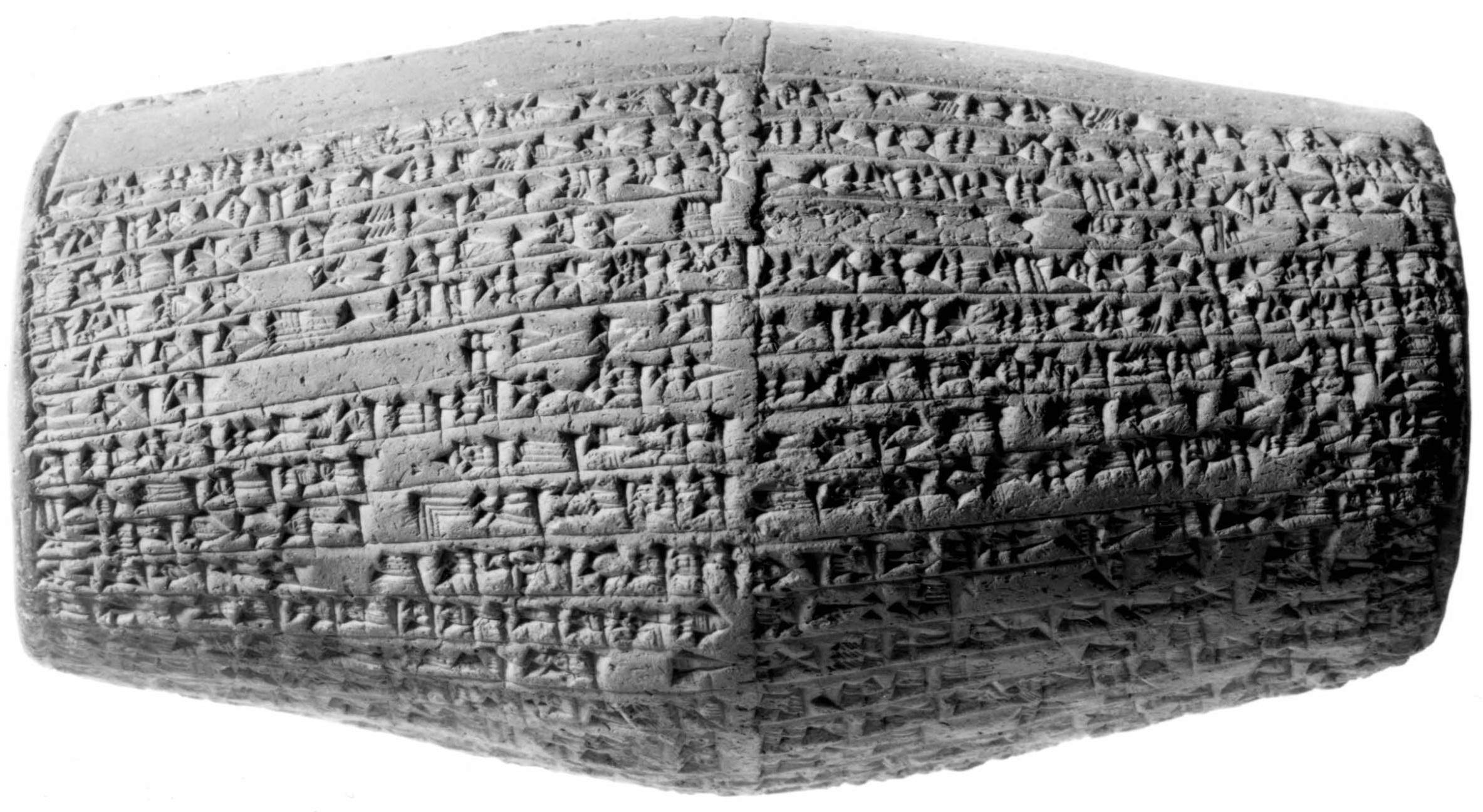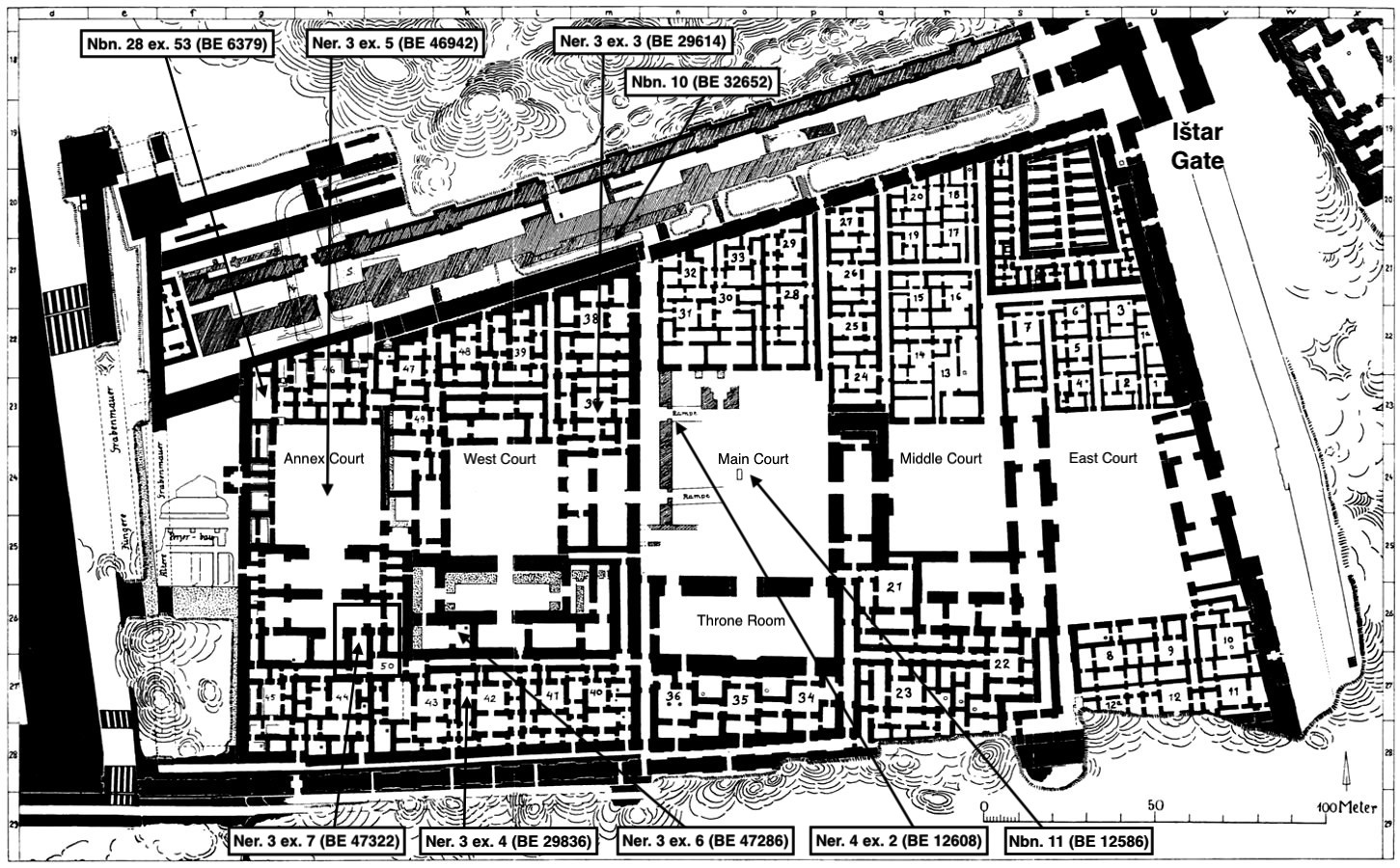Inscriptions of Neriglissar
Jump to Neriglissar 1 Neriglissar 2 Neriglissar 3 Neriglissar 4 Neriglissar 5 Neriglissar 6 Neriglissar 7 Neriglissar 8
At present, nine Akkadian inscriptions of Neriglissar are known. These officially commissioned texts are preserved on fourteen two-column (barrel) cylinders, seven bricks, and an alabaster vase. Some of the objects were discovered at Babylon during Koldewey's excavations, others originate from other sites, including Sippar and the Elamite city Susa. The inscriptions themselves record several building projects at or near Babylon and at Sippar, including the renovation of parts of Marduk's temple Esagil ("House Whose Top is High"), the restoration of a wing of a royal palace that had fallen into the Euphrates River and the securing of that watercourse's banks, and the repair of Šamaš's ziggurat Ekunankuga ("House, Pure Sanctuary of Heaven"). One fragmentarily preserved text of this king is unusual in that it records a military expedition in detail; that inscription may have recorded Neriglissar's campaign to Cilicia, which took place during his third regnal year (557 BC).
Two large, two-column clay cylinders are inscribed with a text of Neriglissar recording that he made restorations to part of Marduk's temple at Babylon, Esagil ("House whose Top Is High"); the script of ex. 1 is archaizing Neo-Babylonian, while that of ex. 2 is contemporary Neo-Babylonian. The king states that he rebuilt one of the temple's enclosure walls since it had fallen into disrepair and was near collapsing; the work took place near to where the ramku- and kiništu-priests of Esagil lived. Neriglissar claims to have laid the new foundations of the wall in the exact same spot as the previous foundations. The inscription is referred to as "Neriglissar Cylinder II, 1," "[Neriglissar] Cylinder C21," or "the Esagil Inscription" in previous studies and editions.
Access the composite text [/ribo/babylon7/Q005386/] or the score [/ribo/bab7scores/Q005386/score] of Neriglissar 01.
Sources [/ribo/bab7scores/Q005386/]
| (1) BM 113233 [/ribo/sources/P345497/] (1915-12-11, 0001) | (2) BM 032550 [/ribo/sources/P518469/] (1876-11-17, 2293) |
Commentary
Ex. 1 (BM 113233) was owned by Emily Ripley when it was studied and copied by E.A.W. Budge in 1888. In 1915, the cylinder was donated to the British Museum by Dr. Laurie A. Lawrence. The master text and lineation are based on ex. 1, the only near-complete witness of this inscription. A score is presented on Oracc and the minor (orthographic) variants are given in the critical apparatus at the back of the book.

BM 113233 (Neriglissar no. 1 ex. 1), a two-column clay cylinder reporting on this king's restorations to Esagil.
Bibliography
An inscription of this Neo-Babylonian king describing the restoration of the Lībil-ḫegalla canal ("May It Bring Abundance"; Babylon's eastern canal) and the strengthening of its banks is preserved on a large, two-column clay cylinder whose surface is badly damaged; the text is written in contemporary Neo-Babylonian script. Neriglissar criticizes the canal's former builder(s) for not reinforcing the banks with bitumen and baked bricks, something which he had his workmen do. The inscription is cited in previous literature as "Neriglissar Cylinder II, 2," "[Neriglissar] Cylinder C22," or "the Lībil-ḫegalla Inscription."
Access Neriglissar 02. [/ribo/babylon7/Q005387/]
Source
Commentary
As already noted by R. Da Riva (SANER 3 p. 120), the surface of the cylinder is very badly damaged and the inscription written on it is extremely difficult to read. The present edition, although based on collation of the original in the British Museum (London), generally follows the one given in Da Riva, SANER 3, with only a few minor changes.
Bibliography
Nine two-column clay cylinders are inscribed with an Akkadian text of Neriglissar written in contemporary Neo-Babylonian script. The inscription records the details of several projects undertaken by this ruler at Babylon: (1) the manufacture of copper mušḫuššu-dragons for a few prominent gateways of Marduk's temple Esagil ("House whose Top Is High"); (2) the plating and decoration of the Dais of Destinies with gold and elaborate ornaments; (3) the renovation and strengthening of the banks of the Lībil-ḫegalla canal ("May It Bring Abundance"; Babylon's eastern canal); and (4) the repair of a wing of the royal palace that had collapsed into the Euphrates River. With regard to the last accomplishment, Neriglissar states that he had his workmen reinforce the banks of the Euphrates with bitumen and baked bricks in order to prevent similar collapses from happening in the future. This text is cited in previous literature as "Neriglissar Cylinder II, 3," "[Neriglissar] Cylinder C23," or "the Royal Palace Inscription."
Access the composite text [/ribo/babylon7/Q005388/] or the score [/ribo/bab7scores/Q005388/score] of Neriglissar 03.
Sources [/ribo/bab7scores/Q005388/]
| (1) Loan Ant-43 [/ribo/sources/P448637/] | (2) BM 040073 [/ribo/sources/P518473/] (1881-02-01, 0037) |
| (3) VA Bab 00620 [/ribo/sources/P518474/] (BE 29614) | (4) VA Bab 00610 [/ribo/sources/P518475/] (BE 29836) |
| (5) VA Bab 01974 (BE 46942) [/ribo/sources/P518476/] | (6) BE 47286 [/ribo/sources/P518477/] |
| (7) Ist B 00017 (BE 47322) [/ribo/sources/P518478/] | (8) Ist B 00002 (BE 30220) [/ribo/sources/P518479/] |
| (9) VAT 22763 (BE 34065) [/ribo/sources/P519724/] |
Commentary
Contrary to Da Riva, SANER 3 p. 125, the collection number of ex. 1 is not ANE 39.1902, but still Loan Ant-43 (information kindly provided by J.H. Stephenson on January 29th, 2020). ANE 39.1902 is a fragment of five-column cylinder with a list of offerings of food and drink. That object appears to have been either a school exercise in which a scribe in training copied an Ur III account onto a cylinder or an ancient or modern fake; for cylinders being used as text carriers of school exercises, see Gesche, Schulunterricht pp. 194–195. According to the original, 1969 slip-book entry of Loan Ant-43 into the Fitzwilliam Museum, this cylinder of Neriglissar was purchased at Babylon around 1811 by Sir John Malcolm, thus, making the cylinder one of the first objects bearing a cuneiform text to have been brought back to Europe and the UK. Ex. 2 (BM 40073) was purchased from Spartali & Co. in 1881.
The master text and lineation follow ex. 1, the only complete witness of this inscription. A score is presented on Oracc and the minor (orthographic) variants are given in the critical apparatus at the back of the book.

Annotated plan of the South Palace showing the general find spots of several clay cylinders and bricks of Neriglissar and Nabonidus, including exs. 2–7 of this text (Neriglissar no. 3). Adapted from Koldewey, WEB@sup{5} fig. 44.
Bibliography
Five bricks, including at least two discovered during the German excavations at Babylon, bear a short, proprietary inscription of Neriglissar; the script is archaizing Neo-Babylonian and the Akkadian text is stamped on at least one of them. One of the bricks (ex. 5) is also inscribed with an Aramaic docket. The king calls himself "the one who renovates Esagil and Ezida"; work on Marduk's temple at Babylon is recorded in text nos. 1 ([Esagil Inscription] ii 9–28) and 3 ([Royal Palace Inscription] i 21–40). This inscription is cited in previous literature as "Neriglissar Brick A I, 1" or "[Neriglissar] Brick Inscription B1."
Access Neriglissar 04. [/ribo/babylon7/Q005389/]
Sources
| (1) BM 000201a+b and BM 000227 [/ribo/sources/P518481/] | (2) BE 12608 [/ribo/sources/P518482/] |
| (3) BE — [/ribo/sources/P518483/] | (4) private collection (Berlin) [/ribo/sources/P518484/] |
| (5) VA Bab 04619 (BE 41298) [/ribo/sources/P518486/] |
Commentary
Ex. 1 is now known only from the hand-drawn facsimile in Rawlinson 1 R (pl. 68 no. 5). The (composite) copy of the inscription was prepared from three squeezes (BM 201a–b and BM 227) of brick(s) found (near) the bank of the Euphrates at Babylon. It is uncertain if these squeezes are still in the British Museum (London) or if they were destroyed by S. Smith on the grounds that they had outlived their usefulness. The master text and lineation follow ex. 1. No score of the inscription is given on Oracc (a) since scores are not provided for texts on bricks (following the model of RIM and RINAP) and (b) since the contents of exs. 3–4 have never been published in any form (photograph, copy, or transliteration).
Bibliography
Two bricks apparently bearing a four-line version of the previous inscription were discovered during Koldewey's excavations at Babylon. Like text no. 4, this short, proprietary inscription of Neriglissar is written in archaizing Neo-Babylonian script. Since no photograph, copy, or transliteration of this inscription has ever been published, it is not known how the text was distributed over the four lines and which cuneiform signs were used to write out the inscription. For these reasons, no edition of the inscription is provided here. This text is sometimes referred to as "Neriglissar Brick A I, 2" or "[Neriglissar] Brick Inscription B2."
Sources
| (1) BE 41545 [/ribo/sources/P518488/] | (2) BE 41544 [/ribo/sources/P518489/] |
Bibliography
An inscription of Neriglissar recording construction on Šamaš ziggurat Ekunankuga ("House, Pure Stairway of Heaven") at Sippar is written on a large, two-column clay cylinder; this Akkadian text is inscribed in contemporary Neo-Babylonian script. Work on the temple tower is reported to have been undertaken because its brick structure had been severely eroded due to heavy rains; the text also states that the previous builder never finished rebuilding it, although he did manage to have it raised to a height of twenty-two cubits. Unfortunately, the passage in which Neriglissar describes his own restorations of the ziggurat is no longer preserved. This inscription is referred to in previous studies and editions as "Neriglissar Cylinder Fragment II, 2" or "[Neriglissar] Cylinder C022." The edition given here is based on the photograph published by R. Da Riva.
Access Neriglissar 06. [/ribo/babylon7/Q005391/]
Source
Bibliography
A fragment of a large, two-column clay cylinder preserves a small portion of an inscription of Neriglissar that records a military expedition in detail, something that is not typical of official Babylonian inscriptions; the script is archaizing Neo-Babylonian. The campaign in question might have been the one against Cilicia (Ḫumê and Pirindu), which took place during his third regnal year (557). The attribution of the text is certain since Neriglissar's father Bēl-šum-iškun is mentioned. This inscription, which might have been composed after the events of 557, is cited in previous literature as "[Neriglissar] Cylinder C011." The edition given here is based on the photograph published by R. Da Riva.
Access Neriglissar 07. [/ribo/babylon7/Q005392/]
Source
Bibliography
A fragment of a vase inscribed with a short text of Neriglissar stating that the vessel once belonged to him was discovered in the ruins of the Elamite capital Susa; the script is contemporary Neo-Babylonian. The inscription records that the stone object had a capacity of two qa and one half akalu, which is slightly over two liters. This text is cited in previous literature as "Neriglissar Vase I" or "[Neriglissar] Vase V1."
Access Neriglissar 08 [/ribo/babylon7/Q005393/]
Source
Commentary
The present whereabouts of Vase V1 is unknown, so the edition of this short inscription is based on V. Scheil's transliteration (MDP 10 p. 96).
Bibliography
Frauke Weiershäuser & Jamie Novotny
Frauke Weiershäuser & Jamie Novotny, 'Inscriptions of Neriglissar', RIBo, Babylon 7: The Inscriptions of the Neo-Babylonian Dynasty, The RIBo Project, a sub-project of MOCCI, 2025 [/ribo/babylon7/Rulers/Neriglissar/Inscriptions/]